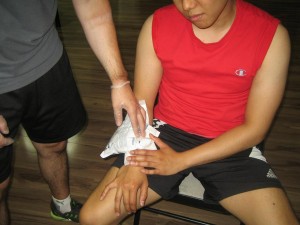Fact Checked
Overview Of Wound Dressing
Small cuts and grazes can be taken care of at home or while traveling on the road. Bigger lacerations might have to be dressed till medical assistance arrives. Hygiene is important when dressing wounds.
Steps To Apply

- Stay protected. If you are not the casualty, perform standard safety measures and wear protective gear if you have access to some.
- A small amount of bleeding is fine; it helps wash out dirt and other impurities from the wound. To prevent bleeding, execute the following steps to manage bleeding and phone for an ambulance if:
- The blood is spewing out or if it is bright red.
- It’s a deep puncture wound on the head, neck, chest, abdomen, pelvis, or back.
- It’s a deep puncture injury on an arm, leg or knee.
- Rinse the abrasion with cool water. Clean the skin surrounding the injury with some soap. Don’t be too concerned if some soap gets into the wound, though it is likely to aggravate the surrounding tissue. Soak the injury carefully to rid it of any grime and soap. Tweezers can be utilized to get rid of particles that might be embedded in the wound.
- Only wrap the injury if it is likely to come into contact with dirt or clothing. If the edges of a cut can’t be easily joined together, then the injury might need stitches. Adhesive dressings are the simplest way to cover small cuts and scrapes.
- Deep cuts are those that expand into the tissues underneath the skin. If you can actually see the tissue along the sides of the cut, then it’s fairly deep. Puncture wounds are trickier to assess, and should be determined depending on how long the object is. Seek medical assistance for a deep injury if:
- It has been more than 5 years since the casualty has had a tetanus injection;
- It’s a cut with serrated edges or can’t close;
- The injury is painful;
- The injury is swollen and red; or
- Pus is draining from the wound (usually yellow pus)
More Steps To Apply
- Hydrogen peroxide is not required to effectively clean a wound. The bubbly effect of hydrogen peroxide produces an oxygen gas – more than the blood can actually handle. Surgeons that use hydrogen peroxide to sanitize deep surgical abrasions have unintentionally triggered gas bubbles in the blood (known as a gas embolism), a potentially lethal situation. Very little proof exists to explain the usefulness of hydrogen peroxide on small lacerations, and lots of proof is available on the merits of plain water – so when cleaning a wound, just use water.
- Antibiotic cream is not essential for a wound to heal properly.
